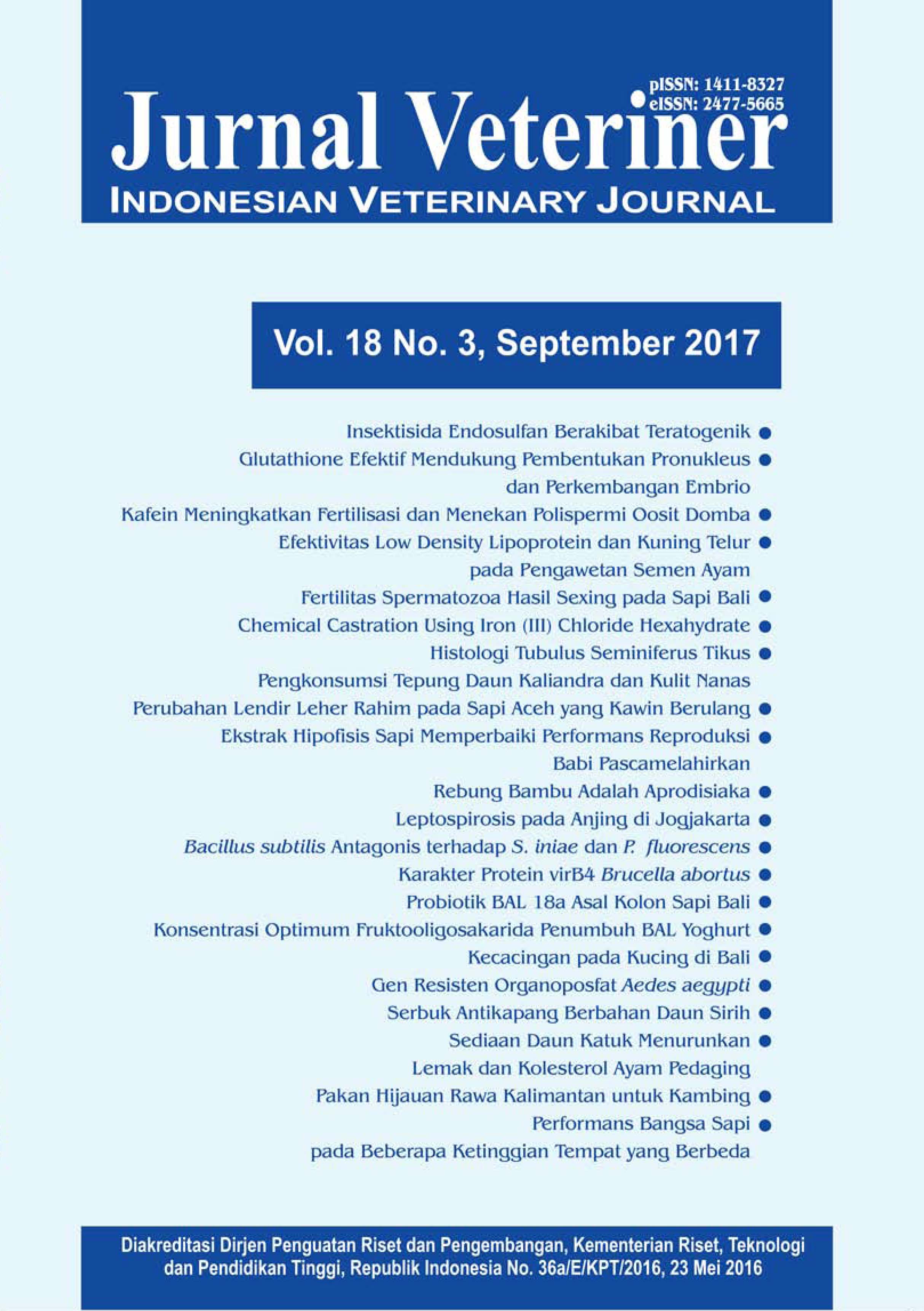Pemanfaatan Ekstrak Hipofisis Sapi untuk Memperbaiki Performans Reproduksi Induk Babi Post Partum (UTILIZATION OF CATTLE HYPOPHYSIS EXTRACT TO IMPROVE REPRODUCTIVE OF POST PARTUM SOWS)
Abstract
This study aimed to evaluate study the influence of cattle hypophysis extract (HE) on the reproductive performance of post partum sows. Twenty landrace sows, 45 days after partum were divided into four groups, five sows each. All were injected with HE intramuscularly. Group I (P0) was injected with 3 ml of saline solution, Group II (P1) was injected with 3 ml contain of 10 mg/EH/Kg body weight (BW), Group III (P2) was injected with 3 ml contain of 20 mg/EH/Kg BW, Group IV (P3) was injected with 3 ml contain of 40 mg/EH/Kg BW. Every sows that showed the estrus symptom were inseminated artificially on the second days, twice each in the morning and evening. The intensity of estrus, length of estrus, number of service preconception (S/C), conception rate (CR), litter size, weight of piglet and milk production were recorded. The result showed that the score of estrus intensity in Group I, II, III and IV were 1.40; 2.40; 2.80 and 2.80 respectively with the length of estrus in each group were 4.40; 5.00; 5.00; 5.60 days respectively. The number of service in Group I, II, III and IV of each pregnancy were 4.40; 1.40; 1.00 and 1.20 with the CR were 0; 60; 100; and 80% respectively. The litter size produced of Group I, II, III and IV were 4.00; 6.00; 10.60; 8.40 respectively. The average of piglet body weight of Group I, II, III and IV were 1.20; 1.36; 1.56 and 1.35 kg respectively. The milk production of each sows of Group I, II, III and IV were 13; 41; 93; 88 g respectively. It can be concluded that cattle hypophysis extract improves the performance of post partum sows with the best level was 20 mg EH/kg of body weight.
ABSTRAK
Penelitian ini bertujuan mempelajari pengaruh pemberian ekstrak hipofisis terhadap performans reproduksi induk babi betina post partum. Penelitian ini menggunakan 20 ekor induk babi betina jenis landrace, dibagi kedalam empat kelompok perlakuan masing-masing terdiri atas lima ekor induk babi. Babi betina yang baru 45 hari menyapih anaknya diinjeksi dengan ekstrak hipofisis (EH) secara intramuskuler. Kelompok I (P0) diinjeksi dengan 3 mL NaCl fisiologis; Kelompok II (P1) diinjeksi dengan 3 mL NaCL mengandung 10 mg EH/kg bobot badan (BB); Kelompok III (P2) diinjeksi dengan 3 mL NaCl mengandung 20 mg EH/kg BB: Kelompok IV (P3) diinjeksi dengan 3 mL NaCl mengandung 20 mg EH/kg BB. Setiap induk babi yang menunjukkan gejala estrus diinseminasi pada hari kedua dengan interval dua kali, pagi dan sore. Peubah yang diamati adalah intensitas estrus, lama estrus, jumlah perkawinan per kebuntingan (S/C), angka konsepsi (conception rate/CR), litter size, bobot lahir anak, dan produksi susu. Hasil penelitian menunjukkan skor intensitas estrus kelompok I, II, III, dan IV masing-masing 1,40; 2,40; 2,80; 2,80 dengan lama estrus masing-masing kelompok secara berturut-turut 4,40; 5,00; 5,00; 5,60 hari. Nilai S/C masing-masing adalah 4,40; 1,40; 1,00; 1,20 dengan CR masing-masing 0; 60; 100; dan 80%. Total jumlah anak yang dihasilkan kelompok I, II, III, dan IV masing-masing adalah 4,00; 6,00; 10,60; dan 8,40 ekor. Rataan bobot lahir anak per ekor pada kelompok I; II; III; dan IV masing-masing adalah 1,20; 1,36; 1,56; dan 1,35 kg. Produksi susu per induk pada kelompok I, II, III, dan IV masingmasing adalah 13; 41; 93, dan 88 g. Simpulan dari penelitian ini adalah ekstrak hipofisis dapat meningkatkan performans induk babi post partum. Dosis terbaik adalah 20 mg EH/kg BB.



















